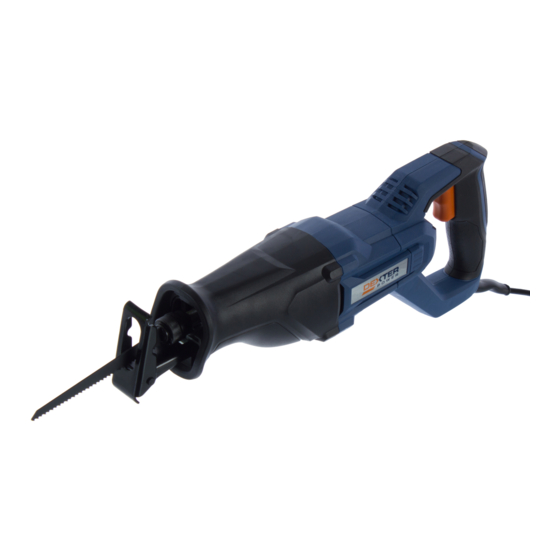- ページ 16
ソウ Dexter Power NC850RSのPDF ユーザーマニュアルをオンラインで閲覧またはダウンロードできます。Dexter Power NC850RS 20 ページ。

Original Instructions
beyond the shoe and the workpiece at all times.
Hex key storage
Fig. 4
The tool has a hex key storage place which is on the handle.
Every time after using, you can store your hex key conveniently,
4.
USE
ON/OFF switch and variable stroke rate control
Fig.5
Your reciprocating saw is equipped with a trigger switch to turn the saw on and off, and to control the stroke rate.
1. To start the saw, press the trigger switch.
2. To stop the saw, release the trigger switch and allow it to return to the OFF position.
3. To vary the stroke rate, simply increase or decrease the pressure on the trigger switch. The tighter the trigger switch is
pressed, the higher the stroke rate.
General cutting
WARNING: Before plugging in the tool, always check to see that the switch is actuated properly and returns to the off position
when released.
WARNING: Hold the tool only by the plastic handle and the insulated grip area, which help prevent electrical shock. When
sawing into walls or floors you may encounter electrical wiring. Sawing into a "live" wire will cause electric shock.
1. Make sure the workpiece is firmly anchored. Clamp the workpiece to prevent slipping or moving while cutting.
2. Use the appropriate type and size of blade for the workpiece material and size.
3. Check for clearance beyond the workpiece so the blade will not impact another surface.
4. Mark the line of cut clearly. If cutting metal, apply cutting oil on the line.
5. Depress the trigger switch to start the saw and bring it to maximum desired cutting stroke rate before applying the blade to
the workpiece.
EN
6. Do not force the tool. Place the shoe firmly on the workpiece while cutting. Use only enough steady pressure on the blade to
keep the saw cutting. Reduce pressure as the blade comes to the end of the cut.
7. Cutting stroke rates should vary with the workpiece. Hard materials such as metals require lower stroke rates, for softer
materials use higher stroke rates.
8. Check wood, chip boards, building materials etc. for foreign objects (nails, screws, etc.) be-fore sawing and remove them, if
necessary.
9. Position the pivoting footplate 2 onto the surface of the work and saw through the work applying uniform contact pressure of
feed.
If the saw blade jams, switch off the tool immediately. Widen the gap somewhat with a suitable tool and pull out the saw blade.
Plunge cutting
WARNING: Plunge cutting is only suitable when working softer materials such as wood or plaster board! However, this
requires a degree of practice and is only possible with short saw blades
1. Place the tool via the pivoting footplate onto the work piece and switch on. Pay attention that the bottom side of the pivoting
footplate 2 faces against the surface of the work piece.
2. Slowly plunge the saw blade into the work piece at an angle. After the saw blade penetrates through the work piece, move
the tool to a vertical position and continue to saw along the cutting line.
3. Switch off the tool and remove it from the work piece.
Plunge cuts can be carried out easier when the saw blade is installed 180° reversed and by guiding the saw the other way around.
16
Dexter Power
